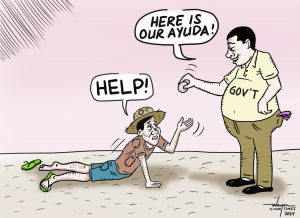We are raising this question because while of late we have seen activities related to addressing the frequent flooding in some areas of the city, specifically its downtown, still the inundation is certain every time heavy rains fall for over an hour.
Since a few months ago we saw the diggings of large and smaller canals and laying of 60- and 48-inches diameter culverts along some interior roads near SPED Bangkal. And there are also open canals apparently connected to the higher elevation C.P. Garcia Diversion road. A few months back before the August 28 flood that destroyed the two bailey bridges that span the Talomo River in Ulas, a huge canal was dug and installed with concrete culvert along Mac Arthur highway at the stretch near a soft drinks company also in that area. Based on announcements made by the Department of Public Works and Highways (DPWH) the drainage project was expected to help reduce incidence of flooding in that part of the city.
During the second half of last year there were also heavy activities along Quezon Blvd., largely installation of concrete pipes to serve as flow route for rain water that drains towards the shore off Bucana. There were also similar work activities along R. Castillo st. in Agdao district.
However, other than some press statements, we have not seen any expansion or dredging work on the city’s major waste water ways like the Roxas canal, the one along Dacudao avenue, the canal in Bacaca and the main drain in Sasa area.
Given the situation and the snail-pace progress of the implementation of the various drainage projects, it does not need much brain to foresee what will happen during long heavy rains in the city. And even if the new drainage lines will work and allow the smooth flow of water to the main canals, still all these will overflow if the capacity is not enough to allow fast exit of water to where it should go – the sea. In such situation, more so if it is high tide, the water is sure to inundate the areas along the canals.
We have no idea whether the width and depth of the canals are considered in the drainage master plan, if we really have one. If not, maybe our city planners can take a harder look at it and do some corrective measures to address the weakness, or add a component or two.
And talking of the city’s drainage master plan we cannot help but think about how the waste water disposal systems of the burgeoning residential subdivisions and high rise communities in the city are suiting up with the former.
In recent years, housing subdivisions were approved in locations like Maa, Mandug, Cabantian, Indangan, Acasia, in Mintal area, Toril, Tugbok and even in the uplands of Eden and Catigan.
The so-called “walled communities” in the Buhangin area of Davao City are being carved out from the mountain slopes. Trees felled, hills are bulldozed to create more plains. Hence, when the subdivision roads and plazas are concreted, and floor areas of houses are cemented as well, the absorptive capacity of the soil is reduced to almost zero. Thus, the water, instead of sipping into the soil, slides direct to the subdivision’s drainage pipes and flows to where the canals or creeks are located. That is, on the assumption that the subdivision developers did not cheat on their regulators on the approved subdivision plans.
But we are very well aware of the fact that there are developers who’d rather sacrifice quality of their subdivisions for as long as they get a much heftier return of their investments.
Has the city, through its physical planning unit, conducted religious assessments on the actual subdivision sites development? Has it validated the approved plan with that of the finished condition of the area being developed?
This, we believe, is one very important responsibility of any regulating body for both residential, commercial, and industrial subdivisions. What is the use of a drainage master plan if this is just being ignored by developers?
And what about the waste water from the burgeoning condominium communities in the city? Are the high-rise residential structures’ waste water disposal system properly connected to the city’s main drainage lines?
At the pace Davao City is developing economically we believe that it is imperative that if at all there is a drainage master plan, the main lines must be accessible for link up by lateral drain system coming from various residential, commercial and industrial enclaves.
Above all, the local government must not only make sure that the drainage master plan has the connectivity mechanism. It must also have attendant legislated policies mandating for strict compliance for all drainage sub-systems that will be connected to it. And these policies must include stringent penalties for violators.

